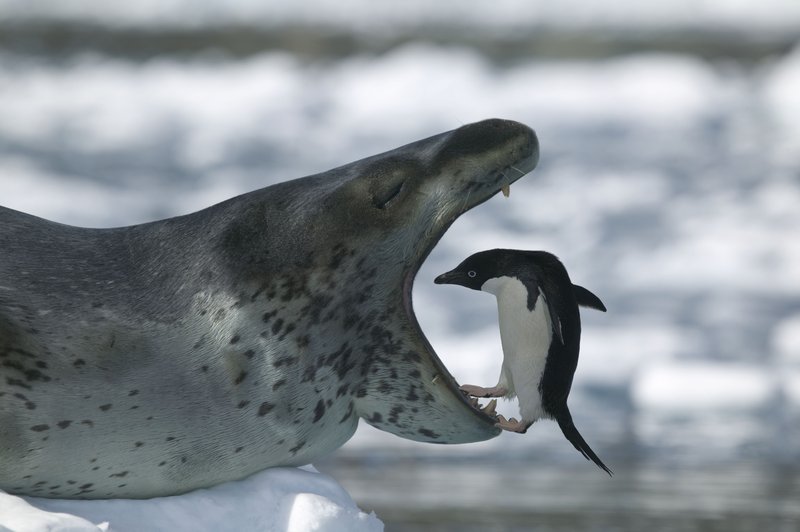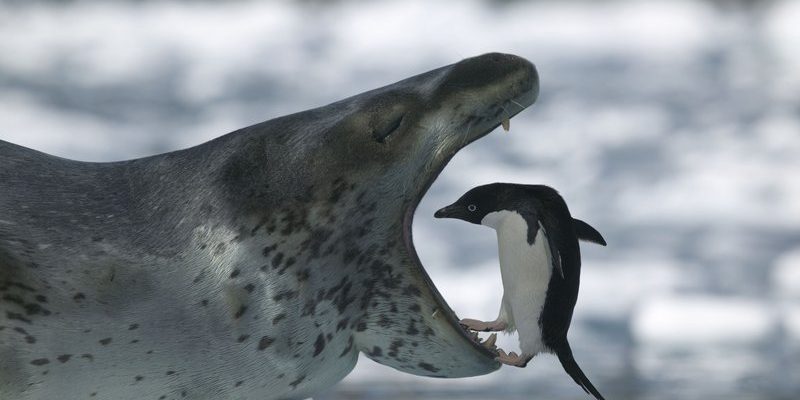
When you think about leopard seals, you might picture them lounging on ice floes, their sleek bodies basking in the sun. But don’t be fooled by their laid-back appearance—these seals are formidable predators. Their diet is varied and adaptable, reflecting the rich biodiversity of their home. Exploring their hunting techniques and meals not only highlights their role in the ecosystem but also shows just how well they’ve adapted to survive in one of the planet’s most extreme environments.
What Do Leopard Seals Eat?
So, what’s on the menu for a leopard seal? Their diet is a mix of prey, showcasing their adaptability and hunting prowess. Primarily, leopard seals feast on:
- Penguins: These seals love a good penguin snack, often hunting species like the Adelie and Gentoo.
- Fish: They consume fish such as krill, which are tiny but abundant in their icy waters.
- Squid: They also enjoy squid, adding variety to their diet.
- Other seals: Believe it or not, leopard seals have been known to hunt smaller seal species as well.
Leopard seals are opportunistic feeders, which means they eat whatever is available. They don’t just stick to one type of prey but rather adapt to changes in their environment. This adaptability is crucial, especially during seasons when food may be scarce. Their flexible diet reflects their survival strategy in the unpredictable waters of Antarctica.
Hunting Techniques of Leopard Seals
When it comes to hunting, leopard seals are nothing short of skilled. They employ a variety of techniques to catch their prey. One common method is known as the “stalking” technique, where they quietly approach their food—think of it like a stealthy cat before it pounces. Here’s how it works:
1. Stealth Approach: They swim slowly, using the underwater topography to hide from their prey.
2. Quick Strike: Once they’re close enough, they use a burst of speed to catch their unsuspecting victim.
3. Playfulness in Hunting: Interestingly, leopard seals often play with their food before eating it, flipping penguins and tossing them in the air, which might seem cruel but is essential for their hunting techniques.
Their hunting strategy is fascinating because it shows how intelligent these seals are. They not only rely on strength but also on finesse and skill to secure their meals. This diverse array of hunting techniques makes them one of the top predators in their habitat.
The Role of Krill in Their Diet
Now, let’s talk about krill. This tiny shrimp-like creature is a vital part of the leopard seal’s diet, especially during certain seasons. Krill are abundant in the Southern Ocean, and leopard seals have developed excellent hunting methods to catch them. Here’s how krill fits into their diet:
– Nutritional Value: Krill are rich in nutrients, providing leopard seals with a high-energy food source. This is crucial for maintaining their large bodies and keeping up their strength in cold waters.
– Swarming Behavior: During feeding season, krill can form massive swarms, making it easier for leopard seals to feast on them. They often use their sharp teeth to filter krill from the water, showcasing their adaptability.
– Competition: Interestingly, leopard seals aren’t the only predators feasting on krill; they share this food source with many other marine animals. This competition can influence their hunting strategies and diet.
Ultimately, krill plays a fundamental role in the leopard seal’s survival and health, demonstrating how interconnected the marine food web really is.
Seasonal Changes and Their Impact on Feeding
Leopard seals face different challenges throughout the year, affecting their feeding habits. During summer, when the ice melts and food becomes more abundant, they have more options. They can also be found hunting in open water, which is a significant shift from the icy conditions typical of winter.
In winter, however, life gets tougher. The ice cover increases, and prey like penguins might be harder to find. During this time, leopard seals often rely more on krill and other smaller fish. The seasonal changes mean that these seals must be adaptable and resourceful to survive.
This fluctuation in food availability not only tests their hunting skills but also their ability to adapt to new eating habits. It’s a constant challenge, but it’s one they meet head-on with their agile, resourceful nature.
Feeding Habits and Social Behavior
Leopard seals are mostly solitary creatures, but their feeding habits reveal interesting social behaviors. While they don’t typically hunt in groups, they sometimes share a meal when they catch something large. This can be seen as a form of social interaction, helping them maintain a loose social structure.
Interestingly, female leopard seals are often seen teaching their pups to hunt. This nurturing aspect shows that while they value independence, they also recognize the importance of passing down survival skills to the next generation. Watching a mother seal teach her pup how to catch krill is a heartwarming scene that highlights the bond they share.
While they may not hunt in packs, their interactions around feeding times can be complex and fascinating, adding another layer to their already rich behavioral repertoire.
How Climate Change Affects Their Food Sources
We can’t talk about leopard seals without mentioning climate change. Changes in temperature and ice cover significantly impact their food sources. As the climate warms, krill populations might shift, and ice-dependent species like penguins can find it harder to survive.
This has a ripple effect on leopard seals. With fewer penguins and krill in the waters, they may have to travel farther or adapt their diets even more. It’s a concerning situation for these magnificent creatures and highlights the importance of addressing climate change to protect their habitat and food sources.
As stewards of the ocean, it’s essential for us to recognize our role in helping these seals and their environment thrive. Their survival isn’t just about them; it’s about maintaining the health of our planet.
The diet and feeding habits of leopard seals reveal much about their adaptability and role in the Antarctic ecosystem. They are skilled hunters, capable of adjusting their diets based on availability and seasons. From penguins to krill, their meals are a testament to their resourcefulness in a challenging environment.
These seals embody the incredible interconnectedness of marine life, and their story is a reminder of the delicate balance of our ecosystems. As we learn more about their habits and the challenges they face, we also recognize the importance of sustainable practices to protect their habitats. Let’s continue to appreciate and protect these remarkable creatures—after all, they remind us of the beauty and complexity of life in the wild.

